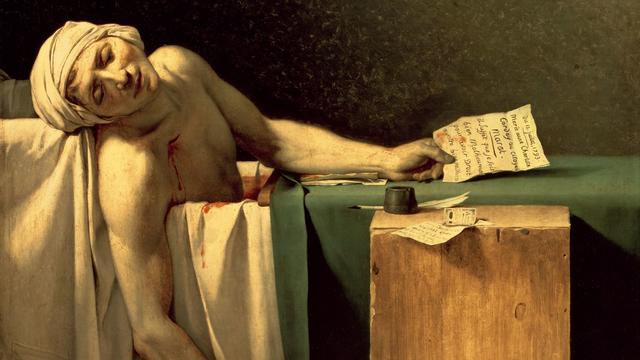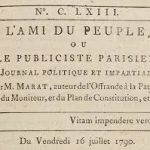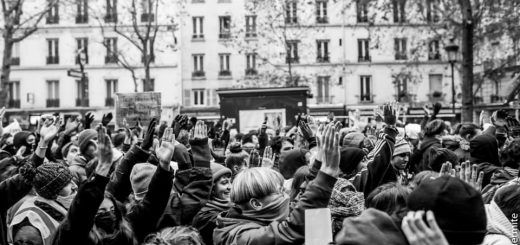On the knife’s edge: the “unlimited freedom of the press”, from Jean-Paul Marat to cyberterrorism

The impact of social networks on political discourse and public debates has become a source of growing concern and the subject of endless controversies.
Originally the development of the social media carried the promise of an easier, more immediate and transparent way to inform citizens, encouraging their participation in discussions and consultations. In Italy, the pioneering 5 Stars Movement, founded in 2009, went as far as to present itself as a novel experiment in direct democracy, thanks to the services of its (privately owned) website “Rousseau”. Soon enough, however, these optimistic expectations have been overshadowed by the emergence of a series of dangerous side effects: massive diffusion of fake news, attempts to manipulate elections, harassment of public personalities and private individuals through sexist or racial insults, down to instances of what is now described as “cyberterrorism”. Less dramatically, but dismally, political communication has been impoverished and vulgarised by the recurrent use of applications such as twitter or facebook by party leaders or in governments’ communications; gatherings and debates have been replaced by the posting of ludicrous selfies and meaningless slogans.
While 21st century technology has of course no precedent in history, the discovery that a new media of democratic exchange could become the instrument of manipulation and persecution, even of murder, is not an entirely novel experience: an instructive precedent is offered by the role of the periodical press during the French Revolution of 1789.
“Crimes of the press”
Under the Ancien Regime, publications in France were subject to preventive censorship. Books and journals could be published (and plays performed) only if they obtained the permission of a Committee of Censors appointed by the Chancellor (ultimately by the King), each of them responsible for a particular domain. The functioning of the system was, inevitably, quite arbitrary: sometimes authors risked a term of imprisonment for relatively mild satirical lines, while on other occasions provocative works were “protected” by one or other of the censors. Understandably many authors chose to publish anonymously (there were no copyright laws anyway), a practice of which we know Jean-Jacques Rousseau strongly disapproved.[1] Predictably this state of affairs generated a clandestine market, ranging from philosophical works to political pamphlets and obscene libels and caricatures, smuggled from abroad or printed domestically with a fake foreign imprint: over the last three decades, historical research has brought to light the unsuspected volume and influence of this black market.[2]
In 1789, the Declaration of Rights (Article 11) proclaimed the principle of the freedom of expression, in speech as well as in writing and print. Between 1789 and 1792, the mechanism of preventive censorship was gradually abandoned, disappearing altogether under the Republic. The result was the vertiginous growth of the volume of publications, with periodicals becoming for the first time far more important than books: the number of journals grew rapidly from a few dozens to well above a thousand. Every revolutionary club or group produced its own periodical; in particular press campaigns were crucial to the access to power of what was originally a militant minority, the Jacobins.
On the whole legislators were well aware of the risks represented by an unbridled press. Article 11 of the Declaration stated that citizens were free to express themselves, but must answer “for the abuse of such liberty in the cases prescribed by the law.” In the attempt to make these indications more specific, on the 20th January 1790 Emmanuel Sieyès and Guy-Jean-Baptiste Target presented to the Constituent the draft of a law “sur les délits de presse”: publications could be sanctioned if they encouraged disobedience to the law or seditious acts, if they insulted the King, voiced calumnies or offended current morality. Throughout the revolution all subsequent governments struggled to bring the press under control while respecting the general principle of freedom of expression (one measure introduced in 1791 was the taxation of periodicals).[3]
These efforts of regulation were denounced by some prominent revolutionary leaders. In a speech addressed to the Société des amis de la constitution, on 9th May 1791, Maximilien Robespierre stated that:
“…all sanction imposed on writings, on the pretext of repressing the abuses of the press, turns entirely to the disadvantage of truth and virtue and to the profit of vice, error and despotism”.[4]
 Another opponent of regulatory legislation was Jean-Paul Marat, a doctor from the Principality of Neuchâtel turned journalist, who edited the virulent L’Ami du peuple. Marat advocated the “unlimited freedom of the press” as necessary to control the action of government’s agents. In fact, his paper used it to target whoever he regarded as a political enemy. On the 13th July 1793 Marat was assassinated by a young woman from Normandy, Charlotte Corday, who held him responsible for the massacres of September 1792, and for the persecution and death of the faction of the Girondins. Though very popular, Marat had never occupied a relevant position in the revolutionary government: his responsibility in the killings was entirely based on the denunciations and appeals to violence voiced by his journal. Corday travelled to Paris, bought a knife and asked to see Marat, claiming she had important revelations to make. In his famous painting “La Mort de Marat”, David shows him holding a letter from Corday, in which she appeals to his compassion; in reality he was apparently hoping for some juicy scoop.[5]
Another opponent of regulatory legislation was Jean-Paul Marat, a doctor from the Principality of Neuchâtel turned journalist, who edited the virulent L’Ami du peuple. Marat advocated the “unlimited freedom of the press” as necessary to control the action of government’s agents. In fact, his paper used it to target whoever he regarded as a political enemy. On the 13th July 1793 Marat was assassinated by a young woman from Normandy, Charlotte Corday, who held him responsible for the massacres of September 1792, and for the persecution and death of the faction of the Girondins. Though very popular, Marat had never occupied a relevant position in the revolutionary government: his responsibility in the killings was entirely based on the denunciations and appeals to violence voiced by his journal. Corday travelled to Paris, bought a knife and asked to see Marat, claiming she had important revelations to make. In his famous painting “La Mort de Marat”, David shows him holding a letter from Corday, in which she appeals to his compassion; in reality he was apparently hoping for some juicy scoop.[5]
Today both Marat and Corday are regarded as martyrs of liberty by different “constituencies” in historiography and opinion: Marat for defending the freedom of the press at any cost; Corday for sacrificing her life (she was guillotined four days after the murder) to silence his ranting, fanatical voice.
“Les Lumières en France ne s’éteignent jamais”[6]
In 1800, at the beginning of the Consulate, Germaine de Staël published a work entitled: De la littérature, considérée dans ses relations avec les institutions sociales. The book was a pioneering comparative history of European literature, seen in the light of the different national traditions. In the second part, dedicated to the present and future prospects of the Enlightenment, the chapter “On eloquence” offered a retrospective assessment of political discourse during the Revolution: an object that the author had been able to observe very closely.
Like many intellectuals, Staël had believed initially that the freedom of the press would favour the circulation of information, bringing political issues closer to the general public. The reality had proved very different. Staël stressed in particular two dismal effects of the new “liberated” press. The first one was the lowering of the level of political rhetoric, through the endless repetition of empty formulas, meaningless catch-phrases and party slogans: “The time has come to reveal to you the whole truth…the People has risen…the Nation was plunged in a deadly slumber… etc.”. The second was the escalation of violence in language: faced with a public used to the most outrageous claims, speakers competed in adopting increasingly ferocious formulas to capture their attention. The result in the end had no political or ideological significance whatever, but carried a dangerous potential of hatred and aggression.
“Words (la parole) – Staël wrote – retain the power of a lethal weapon while having no residual intellectual strength.”
As a woman active in politics, Staël had often found herself at the receiving end of the obscene slander, calumnies and threats of pamphleteers. However, she did not think that imposing a new censorship would help to raise the level of public debate. The poison in the system had not been caused by the press as such, tough no doubt some scribblers took advantage of this easy path to popularity. Its main source was to be found in the dangerous passions that the Revolution had let loose: social envy, personal vanity, and above all “the spirt of party”, fanaticism, the visceral hatred of political enemies. “Stifling eloquence” (as she put it) would deprive of expression these despicable passions, but would kill at the same time the most worthy and noble sentiments.[7]
To make sure that the Enlightenment had still a future in France, the new Republic must elevate the level of public discourse: educating the people, favouring peaceful deliberations and promoting intellectual and artistic excellence. Unfortunately, this ambitious design of cultural renaissance did not seduce the First Consul, who apparently took little notice of the copy of Staël’s book he had been offered. Bonaparte was quite prepared to finance educational institutions and to reward sympathetic writers, artists and scientists; but when it came to dealing with the press he preferred the good old way of preventive censorship. A decree of the 27 September 1803 stated that: “…to ensure the freedom of the press (!) no bookseller will be allowed to sell a work before presenting it to a Commission of revision.”[8] In 1810, the French edition of one of Staël’s most successful books, De l’Allemagne, considered too favourable to the enemy across the Rhine, would be pulped before it could leave the printer’s.
The Good Wife
On the 13th March 1914, just months before the outbreak of the First World War, Henriette Caillaux, wife of the finance minister Joseph Caillaux, fired six shots at the editor of Le Figaro, Gaston Calmette, killing him. The paper had been running an aggressive campaign in view of forcing the minister to resign, voicing vague allegations of corrupt financial deals. The editor’s hostility rested mainly on the fact that Joseph Caillaux had business contacts in Germany, and was generally opposed to the prospect of going to war. As his campaign did not achieve the desired result, Calmette managed to acquire some letters the ministers had addressed to his first wife at the time of their divorce, and to Henriette herself before they were married. The content of the letters was of no political relevance whatever, but with a divorce in between, they offered good opportunities for scandal and ridicule: indeed, the journalist threatened to have them posted “on the walls of all the parishes of France”.
Henriette offered to buy the letters back, but Calmette did not want money, he wanted a political triumph. Admitted to his office at Le Figaro in a state of tearful agitation, the lady produced a small revolver from her elegant muff and shot him. At her trial the accused explained that she had taken legal advice to see whether Calmette could be prosecuted (under the Third Republic the kind of regulatory laws Sieyès had proposed were in place), but she had realised that a legal procedure would be too slow to stop the publication; at that point, she admitted, she had bought the gun.
Unlike Corday, Henriette Caillaux did not go to the guillotine, or even to prison: she was found “not guilty” by the jury, in spite of having confessed to what was clearly a premeditated murder. No doubt the government of Gaston Doumergue wished to spare themselves further embarrassment, days before the general mobilisation; the accused was also protected by sexist prejudice, as her defence presented her as an emotional woman, driven by her sense of honour and by love of her husband (it helped of course that the public felt little sympathy for the deceased).[9] In a painting of 1914 entitled “drame politique”, Robert Delaunay represented the murderess and her victim swept away together within the spires of an irresistible vortex.
On the knife’s edge
The Caillaux affair is just another illustration of how the issue of the freedom of information can often run on a knife’s edge (sometimes it seems literally so). In contemporary democracies, current legislation against the abuses of the media is more or less outdated, and needs to be adjusted to the distinctive features of the web. No doubt the owners of websites can be pressured to exercise grater vigilance on their content. Setting aside technicalities, the adjustments are not very different from those the French revolutionaries had to devise when faced with the sudden “explosion” of periodicals, confronting a new age of communication. Yet by its very nature the machinery of justice can only operate ex post: it cannot offer full redress to the victims of harassment or false allegations, correct prejudices or cancel from the mind of the viewers offensive images, even if they appear for a short lapse of time.
More importantly, unless we are prepared to reintroduce committees of censors, the law cannot easily draw in advance the line between the expression of what Robespierre called truth and virtue, and that of fanaticism, hatred and abysmal stupidity. Similarly, antiterrorist cyber-surveillance struggles every day to distinguish harmless lunacy from real threats. (Incidentally, for those who can remember the 1970s, how would the then current appeals to the “armed struggled of the proletariat” score in the security department?)
Should journalists (and of course writers and teachers and such) exercise a kind of preventive censorship on themselves, refraining from saying things that might “cause offence”? The argument has been set forth in relation to the Charlie Hebdo massacre, but once again, how do you define “causing offence”? Or does it actually mean “causing offence to people with kalashnikofs”?
The problem is that Staël was right: the media (“eloquence”) can only repeat, echo, amplify those beliefs and passions, virtues and vices, that are already present within society. They are the mirror in which reality is reflected, no doubt often magnified, deformed and distorted: powerful mirages, but a mere reflex all the same.
Biancamaria Fontana is Emeritus professor of History of political thought at the University of Lausanne, and a member of the Walras Pareto Centre for the history of economic and political thought. She is the author, among many other books, of Germaine de Staël: A Political Portrait and Montaigne’s Politics: Authority and Governance in the Essais. She is also the editor and translator of Benjamin Constant’s Political Writings, and a regular contributor to the Times Literary Supplement. Her book La République helvétique, laboratoire de la Suisse moderne has just been released.
Footnotes
- Christopher Kelly, Rousseau as Author: Consecrating One’s Life to the Truth, Chicago, Chicago University Press, 2003. ↩
- See the pioneering: Robert Darnton, The Forbidden Best-sellers of Pre-Revolutionary France, New York, W.W.Norton, 1996. ↩
- Claude Labrousse, Pierre Rétat eds., Naissance du Journal révolutionnaire, Presses Universitaires de Lyon, 1989; Jeremy Popkin, Revolutionary News: the Press in France 1789-1799, Duke, N.C., 1990. ↩
- Œuvres de Maximilien Robespierre, Discours I, vol. 6, Société d’études robespierristes, 2007. ↩
- Jean-Paul Marat, Textes choisis, ed. Claude Mossé, Paris, Editions Sociales, 1950; Jean-Denis Bredin, ”On ne meurt qu’une fois”: Charlotte Corday, Paris, Fayard 2006. ↩
- Emmanuel Macron, Speech of 20 Oct. 2020 in memory of Samuel Paty. ↩
- Germaine de Staël, De la littérature, ed. Gérard Gengembre and Jean Goldzink, Paris, Flammarion, 1991, Part 2, Ch. VIII, “De l’éloquence”, pp.393-406. ↩
- Thierry Lentz, Le Grand Consulat (1799-1804), Paris, Fayard, 2014, p.612. ↩
- Les grands procès du XXème siècle, ed. Stéphanie de Saint Marc, Paris, Robert Laffond, 2016, pp.1-55; Jean-Yves Le Naour, Meurtre au Figaro, L’affaire Caillaux, Larousse, 2007. ↩
To cite this blog post : Biancamaria Fontana, « On the knife’s edge: the “unlimited freedom of the press”, from Jean-Paul Marat to cyberterrorism », Blog of the Centre Walras Pareto, November 3, 2020, https://wp.unil.ch/cwp-blog/2020/10/on-the-knifes-edge/.






